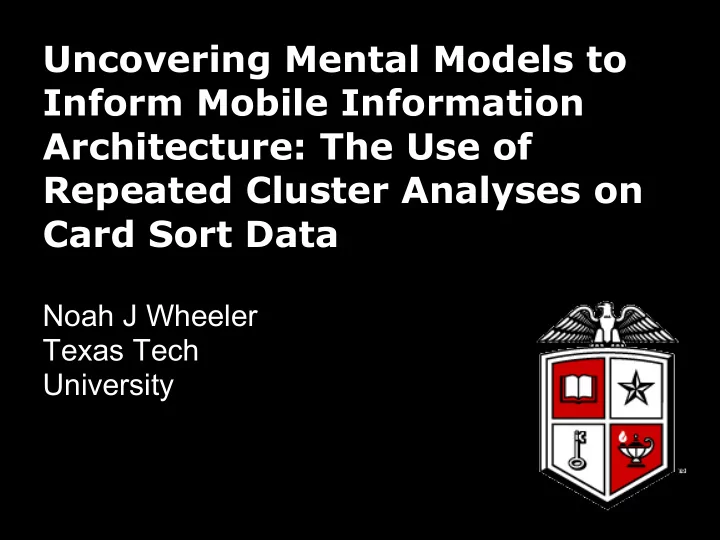

Uncovering Mental Models to Inform Mobile Information Architecture: The Use of Repeated Cluster Analyses on Card Sort Data Noah J Wheeler Texas Tech University
Cluster Background Data Collection Conclusions Analysis
Cluster Background Data Collection Conclusions Analysis Information Architecture "The structural design of shared information environments. The art and science of organizing and labeling web sites, intranets, online communities and software to support usability and findability. An emerging community of practice focused on bringing principles of design and architecture to the digital landscape." - The Information Architecture Institute www.nngroup.com
Cluster Background Data Collection Conclusions Analysis Mobile human interface guidelines frequently suggest a hierarchical information architecture (IA). Card sorting techniques could inform this IA. Card sorting can be used to understand a user's mental representation of information. Aggregating large numbers of items across multiple users can be challenging. www.nngroup.com
Cluster Background Data Collection Conclusions Analysis Cluster analysis is a method that has been used to aggregate users responses (Lewis, 1991). Apple Pear Tree Forest Rock Apple 10 Pear 10 10 Tree 7 6 10 Forest 4 7 9 10 Rock 0 0 0 0 10
Cluster Background Data Collection Conclusions Analysis Cluster analysis is a method that has been used to aggregate users responses (Lewis, 1991). Distance Apple Pear Tree Forest Rock
Cluster Background Data Collection Conclusions Analysis Cluster analysis solutions can be analyzed at different distances. Distance Number of Clusters Toms, Cummings-Hill, Curry, and Cone (2001) used a different method of analyzing cluster analysis solutions.
Cluster Background Data Collection Conclusions Analysis Objective To demonstrate how the method used by Toms et al. (2001) can be used to inform the information architecture of a mobile settings menu.
Cluster Background Data Collection Conclusions Analysis Identified 46 concepts in the iOS 6 settings menu Entered these list of concepts on websort.net Recruited 10 iOS users and provided them a link to the card sort
Cluster Background Data Collection Conclusions Analysis Users visited the URL and sorted Item 1 Item 2 the concepts into groups and named them. Item 1 10 6 I downloaded a proximity matrix from websort.net. Item 2 6 10
Cluster Background Data Collection Conclusions Analysis Conducted a hierarchical cluster analysis Scree plot technique resulted in 37 clusters for 46 concepts I used the average number of groups that users used (i.e., 9) I still had 22 concepts in a single cluster I used the maximum number of groups that a user used (i.e., 16)
Cluster Background Data Collection Conclusions Analysis 1. Privacy and security 4.1. Phone Information 2. Network 4.2. Diagnostic tracking 3. Usage 4.3. Screen reader 4. Detailed settings 4.4. Visibility 5. Incoming calls 4.5. Reset 6. Audio settings 4.6. Keyboard 7. Sync with iTunes on Your Computer 4.7. Phone Settings 8. Battery Usage Display 9. Ad Tracking Settings
Cluster Background Data Collection Conclusions Analysis Implications: Repeated cluster analyses can reveal hierarchical information structures Limitations: Small sample size, lack of validation Future directions: Conduct usability testing to validate this approach to cluster analyses Applications: Mobile user experience designers could possibly use this method to match information architecture to users' expectations
Questions
Recommend
More recommend